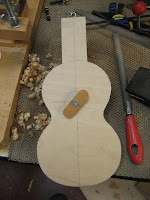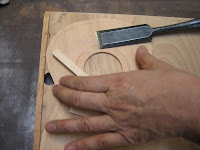



1.Take a piece of Mahogany blank measured approximately 15” x 3” x 7/8” and joint all 4 sides. Cut off two ends about 1 ¼” for heel and mark them to remember how they go in order when gluing for heel stack glue-up. First cut block will go on top of second block cut and those two will stack onto the back of the remaining long piece of the Mahogany blank. Stack the blocks like they will be glued onto the neck and mark a big “X” on the bottom and across the blocks so you remember how they are lined up.
2. Scarf cut a 15 degree angle at a mark measured from the bottom of the neck piece. Measure the length of how long your scale length is from where the 12th or 14 fret will attach to the soundbox. I have a 15” scale length and a 12th fret attachment so my length is 7 ½” add a little more (3/16”) to allow for the curve of the neck to line up with the curve of the soundbox. Make a mark here. This is where you will cut for the scarf joint.
3. Cut the scarf joint on the bandsaw using a sliding jig that goes into your miter slot on your bandsaw. To make the jig: Cut the slider piece out of a hardwood that is the exact measurement of your miter slot. I have a small tabletop 10” Rikon and don’t ask me why but the miter slot is not the standard width! Put some shims into the miter slot, add glue to the hardwood slider piece, put it into the miter slot on your bandsaw (glue face up), lay board on top and clamp. After dry, drill three small countersunk screws into the strip. Glue a block on the top of the board at a 15 degree angle and you’re ready to cut your scarf cut. Make sure your mark in #2 is lined up with the bandsaw blade. That is where you want to make the cut.
4. Glue the two heel blocks onto the end of the long neck piece, gluing up one to the neckpiece and then the next 1¼” block to that. Remember the order. It will match the grain of the neck. Also, glue up the scarf joint. Mike has a permanent stop block where his peghead will be. The peghead end that is chopped off can be slid down to determine your peghead thickness. Two Bessey clamps (KR3.512 ) are used for this operation. Wait a ½ an hour until dry.
5. Take neck over to the jointer or hand sand the sides of the neck.
6. Then take a carpenters marking gauge, find the center line and indent into the wood the center line. Mike didn’t mark the back of the neck but I would like to do that also. That way I can see the CL when I am carving the neck.
7. Mike has a Plexiglas side template he made up to draw the line of the neck and curve of the heel. That is cut out on the bandsaw.
8. Then he has another template to go against the center line of the roughcut neck piece to draw the width of the fretboard and peghead shape.
That's all for today. Next time we will start to carve the neck!
























